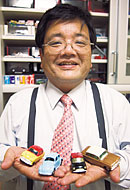Special Feature![]() Exploring Akihabara, Japan’s Electronic Market
Exploring Akihabara, Japan’s Electronic Market

The model railroad diorama on the second floor of Popondetta has 10 tracks. Rental fees are slashed in half on weekdays, and that certainly is an added attraction for young students on their way home from school.
Getting on track with a train set
Popondetta sells model trains. Plenty of them, along with rails, diorama construction accessories, and lots more on five floors from B1 to the 4th floor.
“We stock around 15,000 product types. We have lots of other rail-related items, too—even things like passenger train schedules from the Meiji and Taisho eras (from 1868 to 1926),” says the product manager, Nakase Itaru.
Others attractions include the N-gauge model railway dioramas taking up two-thirds of the second floor. You can rent a track for an hour for 600 to 900 yen and run your own train on it. The store holds make-your-own-diorama classes on Saturdays and Sundays to attract more interest in the hobby. ![]()
Bewitching atmosphere
Morinaga Takuro, economic analyst
I began collecting mini-cars when I was 9, after my dad bought me one. Now I have more than 20,000 of them.
Mini-cars are art. That’s especially true of the older ones, the ones technical guys working for manufacturers designed at a time of cost and technological restrictions, and safety concerns. The cars are not authentic-looking miniatures—some part of the original design is ignored, another part played up. It’s like a crossover, half original character, half manufacturer’s sweat and tears. That’s what is most fascinating about mini-cars.
I often go to Akihabara. Quite a few mini-car stores have opened there over the last five years. Some sell second-hand mini-cars along with the new models. Why is Akihabara a fascinating place? Because you can go really deep into your hobby, and because there’s a flea-market side to it, too. You’ll see things sold on plastic sheets laid on the sidewalk. Keep an eye out and you’ll come away with some great bargains.

